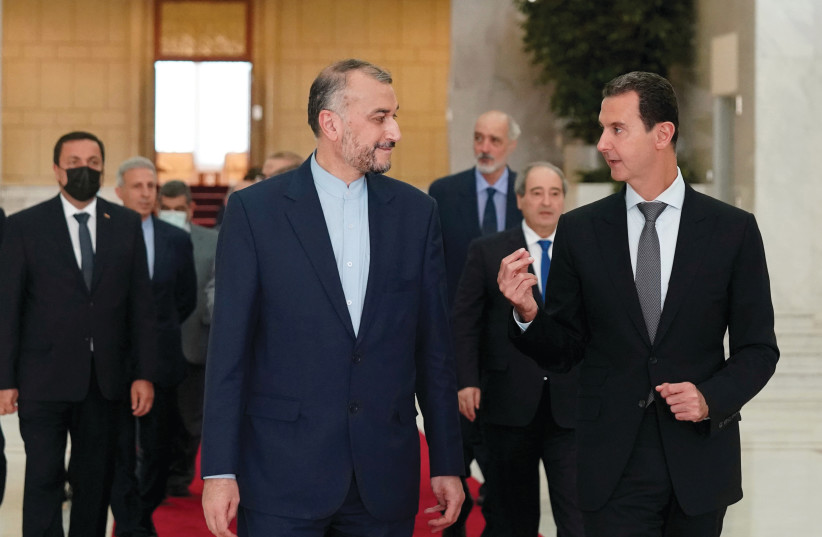At the end of 2020 the USS Nimitz, an American aircraft carrier, was told to return to the US by acting secretary of defense Chris Miller. Then, in a surprising turn of events, it was told to “halt its routine redeployment” and remain on station in the area of US Central Command.
“No one should doubt the resolve of the United States of America,” Miller said.
The anniversary of the US killing of Iran’s IRGC Quds Force commander Qasem Soleimani was coming in a week. The US wanted to be ready for any eventuality.
It was also a period of chaos in the world order. The pandemic had been going on for a year. Israel was just rolling out its first mass vaccination program. In Washington the US president, Donald Trump, was refusing to concede the election. Soon riots would break out in Washington on January 6.
Iran still had Mohammad Javad Zarif as is foreign minister. As the new year dawned, he was spreading rumors that “new intelligence from Iraq indicate that Israeli agent-provocateurs are plotting attacks against Americans” and that this would lead to a “trap” for US president Donald Trump. He alleged a conspiracy was afoot that would plunge the US and Iran into war. We now know that no such thing happened, and it was part of his antisemitic dog whistle that was seeking to portray Israel as the reason for US-Iran tensions.
Indeed, Iran was maneuvering to get on the good side of the incoming Biden administration. Much of the world was doing the same maneuvering. Turkey and Russia were not happy to see the new administration arrive, because they had exploited the Trump administration’s desire to leave the Middle East and “make America great again.” That slogan was part of a new isolationism. Even though Trump had ordered the killing of Soleimani in January 2020, Iran had also exploited the chaos of the Trump era to become more powerful in the region.
By the spring of 2020, several major changes and tectonic shifts were happening in the region.
Turkey was becoming more powerful. It had ordered the US to leave parts of eastern Syria in October 2019 and launched invasions of parts of Syria, recruiting Syrian rebels to fight Kurds in Syria.
Iran was moving into southern Syria, via Iraq’s Al Qaim crossing. It was spreading its forces closer to the Golan. This was part of a plan to move precision-guided munitions and drones to Syria and confront Israel with the possibility of a multifront war. In addition, it had sent its Shahed 136 drones, or a close copy of them, to Yemen. These drones, in the hands of the Houthis or Iranian advisers led by Hassan Irloo, an IRGC-trained envoy, could threaten Israel. Irloo would not live to see the end of 2021. He died of mysterious causes in late December, evacuated by an Iraqi flight to Iran for burial.
This means several parallel developments were happening in the region in January 2020.
Turkey and Iran were increasing their roles in places like Syria. In addition, Turkey and Russia were increasing their roles in places like Libya.
Meanwhile, the rising power of these states was causing the Gulf countries and others to seek a stronger alliance to counter them.
This alliance system was not one that was based on wanting military confrontation, but, rather, to work closely to create an arc of stability that is a contrast to the instability spread by Iran and Turkey in places like Syria, Iraq, Yemen and Lebanon. The arc of stability would be anchored in Abu Dhabi and Jerusalem, with the new peace partners of Israel, the UAE and Bahrain.
As January 2020 turned to February, this meant the new peace partners were working more closely on cementing ties, not only with each other but also with Greece, Cyprus, Egypt, Jordan and India, as well as France and other states.
It should be noted though that this was not a simple process. The UAE was seeking to buy US F-35 advanced 5th generation warplanes. However, there were hurdles to that sale and US concerns about how China had investments in the UAE. This would lead the UAE to turn to France by the end of the year to seek an alternative arms deal. Meanwhile, the US would continue to see China as potentially moving into places that were exclusively US and Western partners. CNN revealed that China was helping Saudi Arabia build ballistic missiles, for instance. The US was also concerned about Chinese investment in Israel. But this US policy move, toward confrontation with China, had come late, after many Middle Eastern countries already saw China as a potential partner. The US was trying to put the toothpaste back in the proverbial tube, in a sense. THESE, THEN, were the broad brushstrokes of 2021. Where would Turkey end up by year’s end? Would it launch new invasions of Syria? Would the US leave Syria under the new US administration? Would Iran continue its threats to US forces in Iraq?
We now know the answers to those questions. Iran shifted the threats in Iraq from supplying militias with 107-mm. rockets to using drones and 122-mm. Grad rockets to threaten the US in Erbil in the Kurdish region of Iraq.
The reason for this was that the US had largely moved its forces away from small facilities in Iraq in 2020, concentrating them in Baghdad, Ain al-Asad base and Erbil. Now Iran decided to export more drones to its allies and use this new type of technology to strike at the US. Drone attacks followed every month for the first six or seven months of 2021.
In July a drone was used by Iran to attack a commercial tanker off the coast of Oman. This was a show of strength by Iran, demonstrating that it could strike the US, Israel, or partner countries anywhere it wants.
We know this was Iran’s plan because of the broad arc of threats. Iran struck at Israel with a drone from Iraq in May 2021, during the Gaza hostilities. Israel’s Defense Ministry twice put out maps and details about Iran’s drone program, revealing the training base at Kashan in Iran and other Iran drone networks. Alma Center revealed that Hezbollah had some 2,000 drones by the end of 2021. Iran also revealed more threats during a military drill in late December, showcasing a new multiple drone launcher and missiles it said could target Dimona.
Meanwhile, Turkey, which had launched invasions and chaos during the Trump era, was suddenly forced to reverse course. Having threatened Greece, stoked a war with Armenia, invaded Syria and threatened Israel while hosting Hamas terrorist leaders, Turkey began to put out signals that it wanted some reconciliation.
This was largely an illusion because Ankara also wanted Israel isolated, having vowed to “liberate al-Aqsa” and threatened the US after Trump moved the embassy to Jerusalem. Turkey also wanted finances for its shaky economy, and was willing to reach out to Egypt, the UAE and other countries to see what it could get.
The opportunist and populist leadership of Turkey was focused on domestic economic problems throughout 2021. This meant that threats of a new invasion of Syria were put off. However, Turkey increased its drone sales to Ethiopia and Ukraine and also pitched drones to Iraq. Turkey also used armed drones to attack Kurds and Yazidis in Syria and Iraq, alleging it was “fighting terrorism.”
WHILE THIS was happening, Israel was confronted in May with a new war with Hamas. This came as prime minister Benjamin Netanyahu continued to try to cling to power.
Iran, exploiting this internal Israeli problem, sought to mobilize Palestinians in Jerusalem and the West Bank. It also got Hamas to put out messaging to spread protests within Israel.
The war that broke out was scripted by Iran and included unique Iranian-designed tests to probe Israel for weaknesses. This included mass rocket barrages by Hamas of 140 rockets fired at a time to try to overwhelm Iron Dome. Israel was not overwhelmed, but Iran also helped Hamas acquire drones to strike at Israel.
The message was clear: Iran believed it could force a multifront war on Israel. Even if the Palestinians were defeated, it could create threats for Israel in Yemen, Syria and Lebanon.
In contrast to this threat, Israel increased its joint training with the US and other partners and allies. It hosted an exercise with the British and Americans called Tri-Lightning and sent F-35s to fly in Italy. It also did a joint naval drill with US Central Command and Bahrain and the UAE in the Red Sea. It hosted US Marines at the same time for training in Israel. This was the highest tempo of joint training in Israel’s history. It came amid a joint drone training in Israel and the Blue Flag drills that saw an unprecedented number of partner countries come to Israel.
Israel was putting itself on the map in military technology in a way it hadn’t before. This was tied to Israel’s increased work with the US defense industry and also talk of more Israeli partnerships in the Gulf and beyond. This is where Israel excels, in developing new technology such as precision weapons, artificial intelligence and air defense. Israel revealed, for instance, that it had used a drone swarm for the first time over Gaza in the May war, and it had used more artificial intelligence. The message was that Israel could confront Iranian-backed adversaries.
For Israel’s friends in the Gulf, though, the big question was whether the US would be leaving the region. After the debacle of the US withdrawal from Afghanistan, it became clear that the US was not going to remain in many places. The US might reassess its role in Syria in 2022. It was taking all its combat troops out of Iraq. This was lip service to appease pro-Iran voices in Iraq. But the larger context was the Iran deal talks in Vienna and major worldwide shifts, as the US pivots to confront China. Many countries wondered if the absence of the US in the region would require them to change their policies.
Toward that end the UAE and Egypt patched things up with the Assad regime, and together with Saudi Arabia they seemed willing to patch things up with Iran as well. At the end of the day, this didn’t fit a clear narrative of who was on whose side in the region. The Assad regime, for instance, is backed by Iran, but countries in the Gulf want it to reincorporate with the Arab League.
With everyone hedging their bets at the end of the 2021, the question was also what Russia and China would do.
Russia and Turkey were playing an increasing role in Africa. China, meanwhile, appeared to have signed a 25-year deal with Iran, and China was becoming more critical of Israeli actions. The overall story was that China believed that if it was going to be confronted by the US, then it would be tougher on Western countries and regional countries that are close to the US.
This presents the US with a problem. It wants to leave the Middle East and Africa to confront China and do near-peer rivalry with Russia in Ukraine. But every time it leaves a place like Afghanistan, it is China and Russia that seek to move into the vacuum. They don’t see it as a zero-sum game; they believe they can move into areas the US is leaving, while the US believes it must leave to focus on China and Russia. This puts US allies and partners in the region in a bind.
At the end of 2021, it remains to be seen what long-term ramifications this major shift will lead to.


